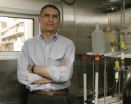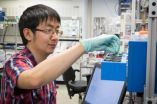(Press-News.org) University of Leeds research has revealed that heart attack patients have a 46% increased chance of death within a month of discharge if they miss any one of nine types of care.
There is also a 74% increased chance of dying within one year if any one component of care is missed.
The nine pathways of care that have been identified are pre-hospital electrocardiogram, acute use of aspirin, restoring blood flow to the heart (known as reperfusion), prescription at hospital discharge of aspirin, timely use of four types of drug for heart attack (ACE-inhibitors, beta-blockers, angiotensin receptor blockers and statins) and referral for cardiac rehabilitation after discharge from hospital.
Dr Chris Gale, of the School of Medicine at the University of Leeds, led the research, which was funded by the British Heart Foundation. He said: "The tragedy of all this is that these deaths are avoidable.
"There is a clear relationship between the ability to provide comprehensive and timely care, and treatment and improved chance of heart attack survival.
"It is vitally important that healthcare professionals working in the heart disease field are made fully aware of, and trained in, these nine types of treatment so that the chances of saving a heart attack patient's life are maximised. Many of these guideline recommended steps are straightforward, but for some reason they are not being provided. If more components of care are missed, the chance of dying increases further."
In the research, based on data from one of the largest registries of quality of care and outcomes for heart attacks, about half of about 31,000 heart attack patients discharged from hospital in England and Wales between January 2007 and December 2010 missed the opportunity to receive a potentially life-saving course of treatment.
Additionally, those cases which missed a course of treatment within the first few hours of the onset of symptoms – such as an electrocardiogram – were at much greater risk of missing other types of care later on.
Professor Peter Weissberg, Medical Director at the British Heart Foundation, said: "The study demonstrates the immense power of collecting 'real world' clinical data from doctors and their patients.
"The key message is that someone's recovery from a heart attack is not solely dependent on any single element of the care pathway. This research shows the importance of ensuring all elements of care for heart attack patients are optimally delivered.
"By focusing on these findings, all centres should be able to improve further the outcome for their patients suffering a heart attack."
The research also showed that hospitals with fewer specialist beds for heart attack patients and hospitals that treated smaller numbers of heart attack patients were more likely to miss opportunities to deliver care. Hospitals with no specialist cardiology beds missed care opportunities 11% more often than hospitals with more than 50 specialist cardiology beds.
The research has been published in European Heart Journal Acute Cardiovascular Care.
INFORMATION:
Further information
Dr Chris Gale is available for interview. Contact Ben Jones in the Press Office on +44 (0)113 343 8059 or email B.P.Jones@leeds.ac.uk
A copy of the research paper, "Mortality and missed opportunities along the pathway of care for ST-elevation myocardial infarction: a national cohort study" by Simms et al is available from the Press Office.
University of Leeds
The University of Leeds is one of the largest higher education institutions in the UK and a member of the Russell Group of research-intensive universities. http://www.leeds.ac.uk
University of Leeds press release: One care lapse can be fatal for heart attack patients
2014-09-15
ELSE PRESS RELEASES FROM THIS DATE:
New insights in survival strategies of bacteria
2014-09-15
Bacteria are particularly ingenious when it comes to survival strategies. They often create a biofilm to protect themselves from a hostile environment, for example during treatment with antibiotics. A biofilm is a bacterial community that is surrounded by a protective slime capsule consisting of sugar chains and "curli". Scientists at VIB and Vrije Universiteit Brussel have for the first time created a detailed three-dimensional image of the pores through which the curli building blocks cross the bacterial cell wall, a crucial step in the formation of the protective slime ...
How an ancient vertebrate uses familiar tools to build a strange-looking head
2014-09-15
Kansas City, Mo. - If you never understood what "ontogeny recapitulates phylogeny" meant in high school, don't worry: biologists no longer think that an animal's "ontogeny", that is, its embryonic development, replays its entire evolutionary history. Instead, the new way to figure out how animals evolved is to compare regulatory networks that control gene expression patterns, particularly embryonic ones, across species. An elegant study published in the September 14, 2014 advance online issue of Nature from the Stowers Institute for Medical Research shows just how humbling ...
Breast screening for over 70s doesn't prompt sharp fall in advanced disease
2014-09-15
Instead, it may just lead to overdiagnosis and overtreatment, suggest the researchers, led by a team based at Leiden University Medical Centre in the Netherlands.
Their paper publishes as the Preventing Overdiagnosis conference opens next week (Monday 15 Sept), where experts from around the world will discuss how to tackle the threat to health and the waste of money caused by unnecessary care. The conference is hosted by the Centre for Evidence-Based Medicine at the University of Oxford in partnership with The BMJ's Too Much Medicine campaign.
The upper age limit for ...
Experts raise concern over unnecessary treatment of mild hypertension in low risk people
2014-09-15
Dr Stephen Martin and colleagues argue that this strategy is failing patients and wasting healthcare resources. They call for a re-examination of the threshold and urge clinicians to be cautious about treating low risk patients with blood pressure lowering drugs.
Their paper publishes as the Preventing Overdiagnosis conference opens next week (Monday 15 Sept), where experts from around the world will discuss how to tackle the threat to health and the waste of money caused by unnecessary care. The conference is hosted by the Centre for Evidence-Based Medicine at the University ...
Genetic testing can identify men at 6-fold increased risk of prostate cancer
2014-09-15
Scientists can now explain a third of the inherited risk of prostate cancer, after a major international study identified 23 new genetic variants associated with increased risk of the disease.
The study brings the total number of common genetic variants linked to prostate cancer to 100, and testing for them can identify 1% of men with a risk of the disease almost six times as high as the population average.
Scientists at The Institute of Cancer Research, London, and in Cambridge, UK, and California led a huge search for new genetic variants including almost 90,000 men ...
Rules of thumb for climate change turned upside down
2014-09-15
Based on models and observations, climate scientists have devised a simplified formula to describe one of the consequences of climate change: regions already marked by droughts will continue to dry out in the future climate. Regions that already have a moist climate will experience additional rainfall. In short: dry gets drier; wet gets wetter (DDWW).
However, this formula is less universally valid than previously assumed. This was demonstrated by a team of ETH climate researchers led by Peter Greve, lead author of a study recently published in Nature Geoscience. Traditional ...
Measuring modified protein structures
2014-09-15
Cells regulate protein functions in a wide variety of ways, including by modifying the protein structure. In an instant, a protein can take on another form and perform no or even the "wrong" function: in humans, proteins that fold wrongly can cause serious diseases such as Alzheimer's, Parkinson's or cystic fibrosis. Some of these proteins also have a tendency to "infect" other molecules of the same type and congregate into insoluble so-called amyloid fibrils or plaques. These amyloids can damage cells and tissues and make people ill.
Method breaks the shackles
Until ...
UNC researchers find final pieces to the circadian clock puzzle
2014-09-15
CHAPEL HILL, NC – Researchers at the UNC School of Medicine have discovered how two genes – Period and Cryptochrome – keep the circadian clocks in all human cells in time and in proper rhythm with the 24-hour day, as well as the seasons. The finding, published today in the journal Genes and Development, has implications for the development of drugs for various diseases such as cancers and diabetes, as well as conditions such as metabolic syndrome, insomnia, seasonal affective disorder, obesity, and even jetlag.
"Discovering how these circadian clock genes interact has ...
Cheaper alternative to licensed drug for treating eye disease has similar side-effects
2014-09-15
Health policies which favour using ranibizumab for treating eye disease in older people over safety concerns for a cheaper alternative should take account of a new Cochrane Review published today. The researchers looked at the results of studies which compared the safety of two drugs used for treating age-related macular degeneration, ranibizumab and bevacizumab. Contrary to what was argued by some experts the review has found that the cheaper drug, bevacizumab, does not appear to increase deaths or serious side-effects compared with ranibizumab in people with neovascular ...
Study sheds new light on why batteries go bad
2014-09-15
Menlo Park, Calif. — A comprehensive look at how tiny particles in a lithium ion battery electrode behave shows that rapid-charging the battery and using it to do high-power, rapidly draining work may not be as damaging as researchers had thought – and that the benefits of slow draining and charging may have been overestimated.
The results challenge the prevailing view that "supercharging" batteries is always harder on battery electrodes than charging at slower rates, according to researchers from Stanford University and the Stanford Institute for Materials & Energy Sciences ...


